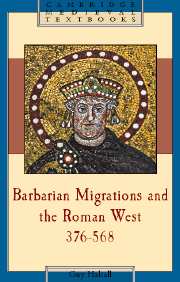Book contents
- Frontmatter
- Contents
- List of maps and figure
- Acknowledgements
- A note on spellings
- Part I Romans and barbarians in the imperial world
- Part II A world renegotiated: Western Europe, 376–550
- 6 The Gothic crisis, 376–382
- 7 The crisis of the Empire, 382–410
- 8 The triumph of the generals, 410–455
- 9 The parting of Gaul and Italy, 455–480
- 10 Kingdoms of the Empire, 476–550
- 11 Provincial society in the long fifth century
- 12 Beyond the old frontier
- Part III Romans and barbarians in a post-imperial world
- Appendix: Gildas' narrative and the identity of the ‘proud tyrant’
- Bibliography
- Index
- Key to map 3 on page 75
- Cambridge Medieval Textbooks
10 - Kingdoms of the Empire, 476–550
Published online by Cambridge University Press: 05 June 2012
- Frontmatter
- Contents
- List of maps and figure
- Acknowledgements
- A note on spellings
- Part I Romans and barbarians in the imperial world
- Part II A world renegotiated: Western Europe, 376–550
- 6 The Gothic crisis, 376–382
- 7 The crisis of the Empire, 382–410
- 8 The triumph of the generals, 410–455
- 9 The parting of Gaul and Italy, 455–480
- 10 Kingdoms of the Empire, 476–550
- 11 Provincial society in the long fifth century
- 12 Beyond the old frontier
- Part III Romans and barbarians in a post-imperial world
- Appendix: Gildas' narrative and the identity of the ‘proud tyrant’
- Bibliography
- Index
- Key to map 3 on page 75
- Cambridge Medieval Textbooks
Summary
With Nepos' murder, the thread connecting the period's narrative history is broken. Henceforth we must consider the history of different regions in turn. This book closes with the collapse of many of the first generation of barbarian realms: the Thuringians in c.532, the Burgundians and Vandals in 534 and the Ostrogoths in 555. The latter two kingdoms were destroyed by Emperor Justinian's eastern Roman armies. Justinian also attacked the Visigoths who, although they survived, were plunged into a period of crisis. Our narrative in this chapter generally stops with the onset of the political instability that led to Justinian's invasions. The Frankish kingdom, which destroyed those of the Burgundians and Thuringians, was involved in Justinian's wars but never suffered invasion. Here our story takes us to the death of Chlothar I, the first Merovingian to rule all Gaul except for Brittany and the Visigothic enclave around Narbonne. In a fashion reminiscent of the art styles emerging in northern Europe at the end of the period covered by this chapter, these individual stories will interlace with each other and with the narrative of Justinian's campaigns given in chapter 15.
ITALY: TWO NATIONS UNDER A GOTH?
In the heart of the former Empire, Odoacer's reign is generally characterised by stability and the continuation of the late imperial order. His army was largely non-Roman but that made little difference from the previous state of affairs.
- Type
- Chapter
- Information
- Barbarian Migrations and the Roman West, 376–568 , pp. 284 - 319Publisher: Cambridge University PressPrint publication year: 2007



